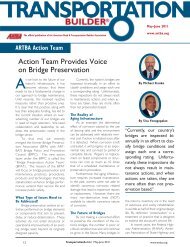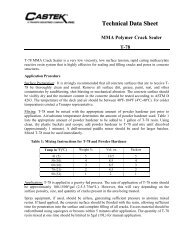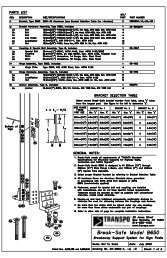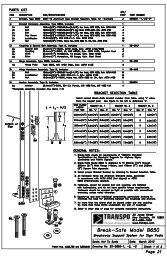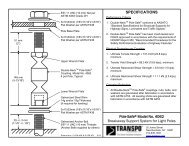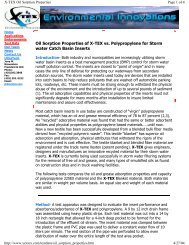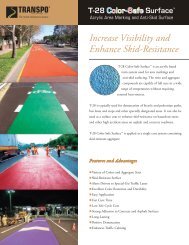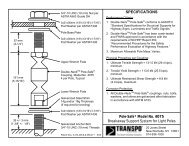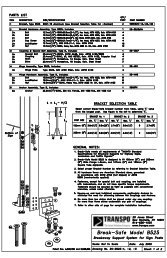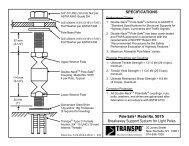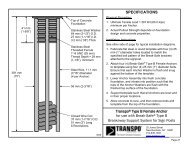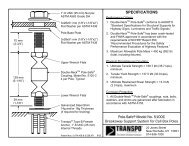Proposed Material Safety Product Data Sheet - Transpo Industries, Inc.
Proposed Material Safety Product Data Sheet - Transpo Industries, Inc.
Proposed Material Safety Product Data Sheet - Transpo Industries, Inc.
You also want an ePaper? Increase the reach of your titles
YUMPU automatically turns print PDFs into web optimized ePapers that Google loves.
euse of shot blast or sandblast media is not recommended<br />
to avoid re-contaminating the prepared surface. If flash rust<br />
appears, the surface must be re-blasted to obtain the<br />
minimum anchor profile. The overlay is to be applied within<br />
the hour after preparation and before flash rushing.<br />
oversize mixing containers. Mix thoroughly for a minimum of<br />
three minutes using a low speed drill (600 rpm) and a mixing<br />
paddle (e.g. a Jiffy® and/or Plunge Mixer). Keep the<br />
paddle below the surface material to avoid entrapment of air.<br />
During mixing it is important to carefully scrape the sides<br />
Asphalt<br />
New asphalt pavement - It is recommended that a period of<br />
two weeks to a month be allowed for the pavement to<br />
oxidize by trafficking.<br />
Existing asphalt pavement - Prior to application of the 526,<br />
the entire area must be power washed 20.7-48.3 MPa<br />
(3,000 - 7,000 psi) with a mild detergent to remove all dirt,<br />
grime, oil and loose contaminants that might affect the bond<br />
between the epoxy binder material and existing surfaces.<br />
Surfaces must be clean and dry; a hot compressed air lance<br />
may be required.<br />
Removal of existing overlays, asphalt etc.: Best removed<br />
by scarification, milling, grinding, bush hammering etc.<br />
Usually creates minute micro-cracking in the substrate<br />
requiring Surface Preparation to a structurally dense surface<br />
with an ICRI profile of CSP #5.<br />
Cleaning: If traffic has been allowed on the prepared<br />
surface or more than 7 days have elapsed since<br />
preparation, the surface will require additional cleaning to<br />
remove the early formation of carbonation and<br />
contamination by sandblasting (if permitted by local<br />
regulations due to health and environmental issues).<br />
Blow, sweep or power-sweep the surface area to be treated.<br />
Blow loose material from visible cracks using oil free, high<br />
pressure air blast.<br />
Temperature Effects: Mixing, Application & Working Time<br />
Epoxy and substrate temperatures have a direct effect on<br />
the usability of the epoxy compound. The quantity and<br />
temperature of the adhesive at time of mixing have a<br />
significant influence on the working time. Elevated<br />
temperatures will thin the epoxy making it easier to apply<br />
but will shorten the working time in the container resulting in<br />
less open time before early polymerization thereby affecting<br />
the bonding ability of the broadcast aggregate. Cooler<br />
temperatures thicken the epoxy, lengthen the working time<br />
in the container and extend the open time prior to the<br />
placement of the broadcast aggregate. Because of the fast<br />
cure rate of E-Bond 526 do not mix a quantity of epoxy at<br />
any one time that cannot be readily applied within the pot life<br />
in the container and the working time on the substrate at the<br />
prevailing temperature. Contact E-Bond Technical Service<br />
for assistance of the gel time in the container and working<br />
time on the substrate at different temperature ranges.<br />
MIXING<br />
For best results, prior to mixing condition the components to<br />
70°- 85°F (21°- 29°C).<br />
Mechanical Proportioning, Mixing: Place 1 volume of the<br />
resin Component (A) and 1 volume of the hardener<br />
component (B) into pre-calibrated flat wall and bottom<br />
containers. Dump the calibrated amounts into a clean<br />
4<br />
and bottom of the mixing container to ensure thorough<br />
mixing of the components. . Mix only the amount of material<br />
that can be used before the working time expires during<br />
application of the surface treatment system.<br />
Automatic Proportioning, Mixing: Mixing equipment that<br />
will automatically and accurately proportion the components<br />
in accordance with the manufacturer’s recommendations<br />
(+/- 2 percent by volume), mix and continuously place the<br />
polymer overlay.<br />
For assistance in the curing process when the substrate<br />
temperature is 75°F and falling, it is recommended that both<br />
components be preheated up 90±10°F (32.2°C) prior to<br />
blending. The operation should proceed in such a manner<br />
that will not allow the mixed material to separate, dry, be<br />
exposed or otherwise harden in such a way as to impair the<br />
retention and bonding of the high friction/Skid resistant<br />
surfacing aggregate.<br />
APPLICATION<br />
Concrete & Steel<br />
Multi Layer Epoxy Overlay Systems consist of two distinct<br />
steps: applying an epoxy polymer and a specified aggregate<br />
in two separate layers at the minimum polymer and<br />
aggregate application rates for the individual layers. (See<br />
application rate chart on page 2).<br />
1. The deck should be marked in sections to provide a<br />
visual guide to insure that the mixed quantity is applied<br />
at the specified rate (thickness).<br />
2. The mixed epoxy polymer is placed on the surface and<br />
immediately and uniformly spread by a notched<br />
squeegee at the coverage rate. Use continuous mixes<br />
(every 3 minutes), placing each successive mix<br />
immediately behind the former.<br />
3. Each batch should be dumped within 6 minutes and<br />
aggregate broadcasted immediately within 10-45<br />
minutes (Hot/Cool substrate) until a dry layer of<br />
aggregate is present over the entire surface. If wet<br />
spots develop, immediately broadcast additional<br />
aggregate until a dry surface is re-established.<br />
Accomplish aggregate broadcast while the epoxy is still<br />
fluid, but keep a wet edge.<br />
4. In cool weather applications 50-59°F (10-15°C)<br />
precondition all components to 80-100°F (27-38°C)<br />
before mixing and applying (consult E-Bond Technical<br />
service for other alternates). For cool applications a<br />
hand operated roller may be necessary to ensure the<br />
aggregate penetrates the cool resin.<br />
Distributed By



